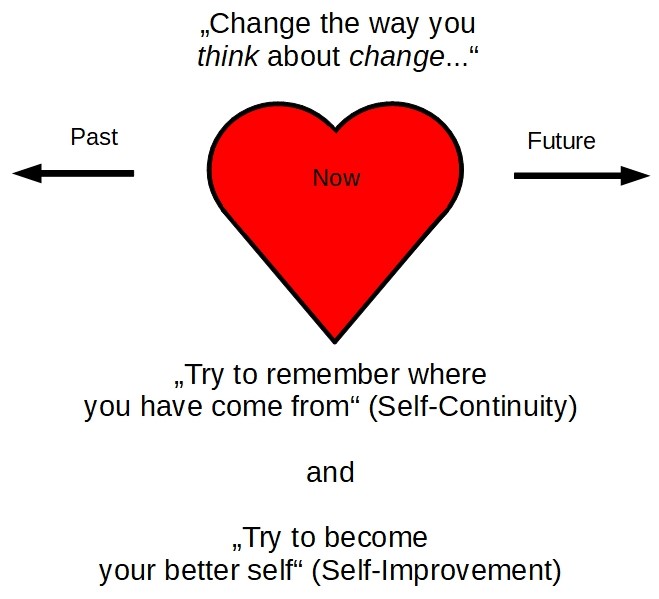When we have to choose between a short term or long term benefit one factor appears to dominate our decision, namely how we relate to our future self. Are we able to see ourselves as this future self that is going to benefit from this long term choice or is this future self rather a stranger to us whose well-being might not be at the forefront of our considerations?
Social psychologists describe this phenomenon with the term self-continuity, i.e. the extent to which we can relate to our changing self over time. Hal E. Hershfield in his paper “Future self-continuity: how conceptions of the future self transform intertemporal choice” explored the above aspect with respect to temporal discounting, behavioral economics and retirement saving.

Self-Continuity (Picture: Evgeny Atamanenko)
To create a particularly “vivid perception of one’s self in the future” Hershfield employed a combination of software and … , immersive virtual reality (VR), to make the perception of the future self more realistic”.
The experiment was carried out as follows: “… college undergraduates entered a VR environment in which they could view images of themselves in a virtual mirror. A control group of college undergraduates viewed a digital representation of their current selves in a virtual mirror, while the experimental group of college undergraduates saw an age-progressed version of themselves in the mirror. While viewing these avatars, all participants spent approximately five minutes answering questions about themselves that have previously been shown to enhance identification with a viewed avatar. Upon exiting the VR environment, all participants were given, among other tasks, a hypothetical monetary allocation task.”
What Hershfield and his colleagues found:”As hypothesized, those participants who were exposed to their future selves were subsequently more likely to allocate money toward a hypothetical retirement savings account than were control participants.”
The message of Hershfield and his colleagues research findings is loud and clear: “…the empirical work presented in this review suggests that when the future self seems similar to the present self, when it is imbued with realism and vividness, and when it is seen in positive terms, people are more willing to make sacrifices today that may benefit them at some point in the years to come.” In other words, if you are able to successfully connect with your future self (self-continuity) you are already well on your way to overcome procrastination.
You got it?
Of course, if you do not happen to be the aging person in the picture above, you might not identify with that “aged version of yourself” and quite to the contrary possibly develop a dislike for old age and that person in particular. This is not my intention though a danger that we always face.
The challenge therefore is to understand and apply the concept of “Self-Continuity” in a meaningful way for yourself. Is there a personal narrative identity that you can refer to. Do you have an evolving story of self that provides you with a sense of unity and purpose in life?
We can all appreciate the changes that our life and body undergoes but are we also able to make sense of them to develop and support a robust “Self-Continuity”?
“Self-Continuity” is important for us, because it allows us to connect and act constructively on behalf of our future self. But continuity is only beneficial if it is on purpose, positive and allows for growth and improvement.
In the western or industrialized world having a positive and accepting attitude towards yourself cannot be taken for granted. Using the picture above, we might focus on deficiencies, defects or faults of the skin with aging. We can easily see that some of those aspects and such a critical view will not support us in developing a healthy attitude towards ourselves. Often we have to find our own standard of beauty and well being, if we want to stay positive, happy and well. Realism and a positive attitude as a function of “Self-Acceptance“, or as discussed here, based on a balance of “Self-Continuity” and “Self-Improvement” (Try to become your better self) can then become the key to overcoming procrastination (see picture below) and to leading a happy and productive life.
While living in the “present moment” we can connect to our past and future to identify what is meaningful, liberating and identity-establishing.

Overcome Procrastination with “Self-Continuity” AND “Self-Improvement” (Picture: Felix Schürholz)
This process, in practice, might not be as easy as it looks. It can be quite challenging and it can also be quite amusing, if you start to exaggerate things in terms of “Self-Improvement” activities, as Carl Cederström and André Spicer document in their Guardian article “We dedicated a year to self-improvement: here’s what it taught us”.
The secret, as with all things, is to try to find the right balance in what you are doing and if possible identify a system that gives you a structure and that fits you best, to operate in.
The system that works well for me is described in my book “Decision Timing“. In Chapter Fifteen, Section 1 (Pages 421 – 425), I particularly deal with the aspect of how you can integrate “Self-Continuity” and “Self-Improvement” in practice to overcome procrastination. Please note, the terms that I use in the book are slightly different, there you will find the “Big Picture” (for Self-Continuity) and “Incremental Improvements in Decision Making” (for Self-Improvement). Essentially they mean the same thing!
You have reached the end of this article? Congratulations! Now you can put everything into practice and remember: “Accomplishment creates confidence, which creates effort resulting in more accomplishment.” (Definition of Piers Steel for “Success Spirals”, by the way, another great way to overcome procrastination)
You want to know more about decision timing, how to practice it, how to get decision coaching or other ways to overcome procrastination, just contact me under “contact(“at”)decisiontiming.com”
All the best! Yours, Felix Schürholz
Article by Felix Schürholz, 13th August 2017, www.decisiontiming.com
2 thoughts on “How to overcome procrastination with “Self-Continuity” AND “Self-Improvement””
Comments are closed.